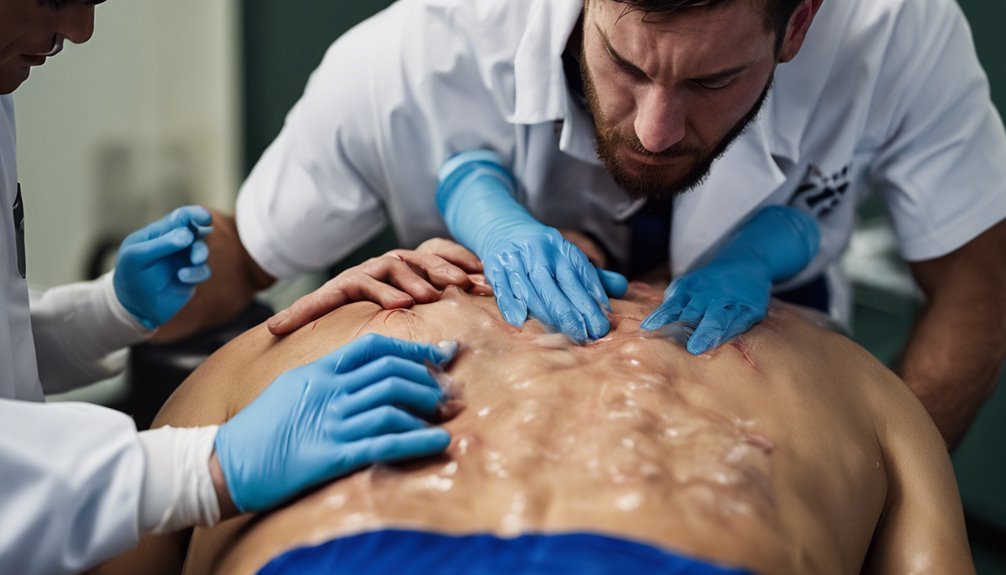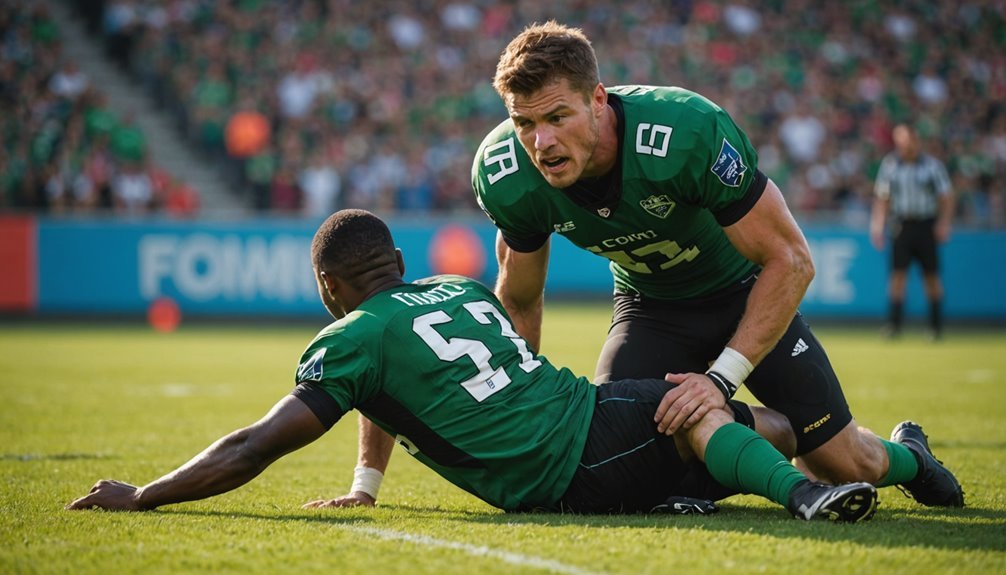You’ve probably heard of stinger injuries if you’re into contact sports, but what exactly are they? These injuries, also called burners, occur when the nerves in your neck and shoulder get compressed or overstretched during an impact. You might experience sudden pain, a tingling sensation, or even numbness in your arm. While these symptoms often resolve quickly, there’s more to understand about the underlying risks and how to manage them properly. What happens if it’s not handled correctly? Your curiosity about potential complications and safe recovery might lead you to uncover the answers.
Key Takeaways
- Stinger injuries, or burners, are nerve injuries affecting the brachial plexus in contact sports.
- They result from neck and shoulder nerve compression during traumatic incidents like tackles.
- Symptoms include sudden arm pain, burning sensation, numbness, and weakness.
- Stinger injuries often resolve quickly but require proper management to prevent long-term issues.
- Medical evaluation and imaging may be necessary for persistent or severe symptoms.
Understanding Stinger Injuries

Have you ever heard of a stinger injury known as a burner? It’s a common occurrence in contact sports, and if you’re an athlete, you might have experienced it.
Stingers are brachial plexus injuries that occur when the nerves running through your neck and shoulder are traumatized. This can happen during a tackle or a fall, causing a burning sensation, numbness, and weakness in your arm. The symptoms might be alarming but often resolve within minutes to hours.
Experiencing a stinger isn’t uncommon—up to 65% of college football players report having at least one. The good news is that most athletes can return to sports quickly after such an injury.
However, it’s vital to understand that repeated incidents can lead to more severe issues. That’s why preventive techniques are essential. Proper tackling techniques and conditioning can help reduce the risk of stingers by minimizing excessive neck extension and pressure on the brachial plexus during high-impact activities.
Awareness of the mechanics of your neck and shoulder during play can make a significant difference in avoiding these painful injuries and keeping you in the game.
Causes and Risk Factors
Understanding stinger injuries’ causes and risk factors is key to preventing them. These injuries usually happen when the brachial plexus, a network of nerves running from your neck to your shoulder, gets overstretched or compressed. This often occurs during head-down contact in tackles while playing contact sports.
Football, rugby, wrestling, and hockey are high-risk because they involve intense physical contact and forceful neck movements. In these scenarios, a sudden force might pull your arm down while your head is pushed sideways. This motion can pinch or stretch the nerves, leading to a stinger injury.
If you’re an athlete with pre-existing conditions like spinal stenosis, you’re at an even higher risk. Spinal stenosis means your spinal canal is narrower than usual, which can increase nerve compression during these forceful impacts.
Awareness of these risks is important, especially since stinger injuries are quite common in contact sports. Did you know about 65% of college football players report having experienced at least one stinger? This statistic highlights the prevalence of such injuries and underscores the importance of understanding their causes and risk factors.
Recognizing the Symptoms

Experiencing a stinger injury can be alarming, as it often radiates a sudden burning or tingling sensation down your arm. This common nerve injury typically results from trauma to the neck or shoulder during contact sports.
Recognizing stinger symptoms is imperative. You might feel severe pain localized in your neck and shoulder, with noticeable weakness in your affected arm. This weakness can make lifting or moving your arm challenging, leading to clumsiness in your movements.
In addition to weakness, numbness in your arm or fingers may accompany the tingling sensation. These symptoms usually resolve quickly but can persist from seconds to days.
It’s important to monitor symptoms closely, as persistent numbness, tingling, or weakness might suggest a more serious condition that could require medical evaluation. Differentiating a stinger from more severe injuries is critical, as they can mimic each other.
Being aware of these symptoms can help you respond promptly if you participate in contact sports. Should your symptoms linger or worsen, you should seek a thorough assessment to verify that you’re not dealing with a more significant injury.
Medical Evaluation
When you notice symptoms of a stinger injury, seeking a medical evaluation is important to guarantee proper care and recovery. Your doctor will start with a detailed discussion about your symptoms, how the injury happened, and when you first noticed the symptoms. This helps them understand the extent of your injuries. They will conduct a neurological exam to evaluate sensory and motor functions in your affected arm, checking reflexes, strength, and sensation.
If symptoms persist or there’s significant weakness, imaging studies like X-rays or a magnetic resonance imaging (MRI) scan might be necessary. These help rule out structural damage to your head, neck, or spinal areas.
| Evaluation Step | Purpose | Professional Involved |
|---|---|---|
| Symptom Discussion | Understand injury mechanism and onset | Doctor |
| Neurological Exam | Assess reflexes, strength, sensation | Doctor |
| Imaging Studies (MRI) | Identify structural damage | Radiologist |
If your symptoms affect both arms or you have recurrent stingers, further evaluation is essential to exclude more serious conditions. A physical therapist or athletic trainer may also be involved to guarantee a safe return to your sports activities. Prompt medical evaluation is key for a proper treatment plan.
Treatment Options

To manage a stinger injury, start with immediate pain relief by applying ice and taking non-steroidal anti-inflammatory drugs (NSAIDs) to reduce inflammation.
Focus on rehabilitation to regain strength and range of motion through physical therapy as symptoms improve.
To prevent further complications, don’t return to sports until all symptoms, including pain and numbness, have fully resolved.
Immediate Pain Relief
It’s important to take a few effective steps for immediate pain relief from a stinger injury. Stingers are injuries common in contact sports, and managing them promptly can prevent further discomfort.
Start by applying ice to the affected area to reduce inflammation and numb the pain. Over-the-counter analgesics like ibuprofen or acetaminophen can also help manage pain and discomfort.
Resting the affected arm is significant. Avoid activities that might worsen the injury, allowing your body to heal properly. This initial rest period is crucial for immediate pain relief and preventing aggravation.
Monitoring the injury is equally important. Look for any persistent weakness or severe pain, which could indicate a need for further medical evaluation.
If symptoms persist, a soft collar might be recommended to limit neck movement and provide necessary support during recovery. This can help stabilize the area and aid in the healing process.
Rehabilitation and Recovery
Rehabilitation and recovery from a stinger injury involve a strategic approach to guarantee complete healing and prevent recurrence. Initially, you’ll want to focus on rest and applying ice to manage pain and reduce inflammation.
As symptoms begin to resolve, physical therapy becomes essential. A therapist will guide you through exercises designed to restore strength, improve your range of motion, and increase flexibility in your neck and shoulder. These exercises are tailored to your specific recovery needs, helping you return to your daily activities without risking further injury.
It’s vital to avoid returning to sports or strenuous activities until all symptoms, such as pain, numbness, and weakness, have completely disappeared.
Persistent symptoms or recurrent stingers may require protective gear, like neck rolls or elevated shoulder pads, to safeguard against future injuries. In cases of severe injury, additional pain management strategies or even surgical intervention might be necessary to address nerve damage.
Always consult with a healthcare professional for a personalized recovery plan. By following these steps, you can effectively navigate the rehabilitation process and guarantee a safe and successful recovery.
Returning to Sports
Returning to sports requires careful attention and a step-by-step approach when dealing with a stinger injury. It’s essential to guarantee that all pain, numbness, and tingling in your neck, shoulder, and arm have completely resolved.
This injury can be tricky, but rushing your return to sports could lead to further complications. Before you even think about returning to the field, your neck, shoulder, and arm should have a full range of motion. Strength recovery in these areas is equally important. You’re not ready to return if there’s any lingering weakness.
Consulting with a healthcare professional is a significant step in this process. They’ll evaluate your post-injury condition and determine if you’re safe to participate in sports again. It’s not just about feeling ready; it’s about being medically cleared to return.
Once you’re back, monitor your condition for recurrent symptoms and consider using protective gear to prevent future stinger injuries. This will ensure that you stay in top shape and avoid setbacks.
Frequently Asked Questions
How Long Does a Stinger Injury Take to Heal?
You might heal from a stinger injury in minutes to hours, but it can last days if severe. If symptoms persist over two weeks, see a doctor. Proper care and rehab speed up recovery and guarantee a safe return to sports.
Is a Stinger a Serious Injury?
You might wonder if a stinger is serious. It typically isn’t, as symptoms often resolve quickly. However, if numbness or weakness persists beyond two weeks, seek further evaluation since it could indicate a more significant issue.
What Is a Stinger Injury in the NFL?
You often hear about stinger injuries in the NFL, where players experience neck or shoulder trauma during tackles. This affects the nerves controlling the arm, causing burning pain and weakness. Recovery is quick, but symptoms sometimes need medical attention.
How Do You Treat a Stinger?
You should start by resting and applying ice to reduce inflammation. For discomfort, use over-the-counter pain relievers. Once symptoms improve, do range-of-motion exercises. Don’t return to sports until you’re fully symptom-free. Consider physical therapy if needed.
Conclusion
In managing a stinger injury, it’s essential to prioritize your recovery to prevent long-term issues. Recognize the symptoms—sudden pain, burning, numbness, or weakness—and seek prompt medical evaluation. Follow the recommended treatment plan, including rest, physical therapy, and a gradual return to activity. Don’t rush back into sports; ensure you’re fully healed to avoid further injury. Taking these steps helps guarantee you can safely return to the game you love.

